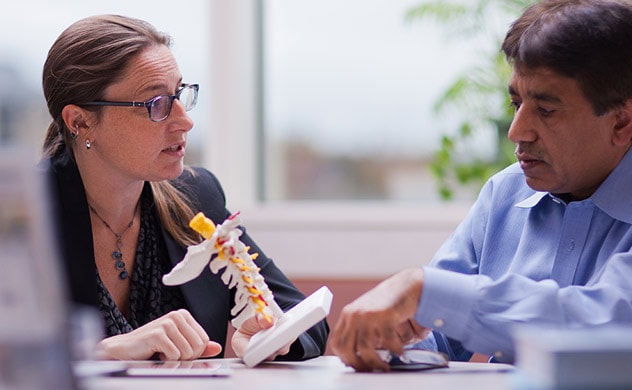Sore Lump on Spine in Middle of Back
Overview

A spinal tumor is a growth that develops within your spinal canal or within the bones of your spine. A spinal cord tumor, also called an intradural tumor, is a spinal tumor that that begins within the spinal cord or the covering of the spinal cord (dura). A tumor that affects the bones of the spine (vertebrae) is called a vertebral tumor.
Spinal cord tumors may be classified as one of three different types depending on where they occur relative to the protective membranes of the spinal cord.
These are the main types of intradural tumors:
- Intramedullary tumors begin in the cells within the spinal cord itself, such as gliomas, astrocytomas or ependymomas.
- Extramedullary tumors grow in either the membrane surrounding the spinal cord or the nerve roots that reach out from the spinal cord. Although they don't begin within the spinal cord itself, these types of tumors may affect spinal cord function by causing spinal cord compression and other problems. Examples of extramedullary tumors that can affect the spinal cord include meningiomas, neurofibromas, schwannomas and nerve sheath tumors.
Tumors from other parts of the body can spread (metastasize) to the vertebrae, the supporting network around the spinal cord or, in rare cases, the spinal cord itself.
Spinal tumors or growths of any kind can lead to pain, neurological problems and sometimes paralysis. A spinal tumor can be life-threatening and cause permanent disability.
Treatment for a spinal tumor may include surgery, radiation therapy, chemotherapy or other medications.
Find out why Mayo Clinic is the best place for your care.
Types
- Astrocytoma
- Chordoma
- Ependymoma
- Glioma
- Meningioma
- Neurofibroma
- Schwannoma
Symptoms
Spinal cord tumors can cause different signs and symptoms, especially as tumors grow. The tumors may affect your spinal cord or the nerve roots, blood vessels or bones of your spine. Signs and symptoms may include:
- Pain at the site of the tumor due to tumor growth
- Back pain, often radiating to other parts of your body
- Feeling less sensitive to pain, heat and cold
- Loss of bowel or bladder function
- Difficulty walking, sometimes leading to falls
- Back pain that's worse at night
- Loss of sensation or muscle weakness, especially in your arms or legs
- Muscle weakness , which may be mild or severe, in different parts of your body
Back pain is a common early symptom of spinal tumors. Pain may also spread beyond your back to your hips, legs, feet or arms and may worsen over time — even with treatment.
Spinal tumors progress at different rates depending on the type of tumor.
When to see a doctor
There are many causes of back pain, and most back pain isn't caused by a tumor. But because early diagnosis and treatment are important for spinal tumors, see your doctor about your back pain if:
- It's persistent and progressive
- It's not activity related
- It gets worse at night
- You have a history of cancer and develop new back pain
- You have other symptoms of cancer, such as nausea, vomiting or dizziness
Seek immediate medical attention if you experience:
- Progressive muscle weakness or numbness in your legs or arms
- Changes in bowel or bladder function
Get Mayo Clinic cancer expertise delivered to your inbox.
Subscribe for free and receive an in-depth guide to coping with cancer, plus helpful information on how to get a second opinion. You can unsubscribe at any time.
To provide you with the most relevant and helpful information, and understand which information is beneficial, we may combine your email and website usage information with other information we have about you. If you are a Mayo Clinic patient, this could include protected health information. If we combine this information with your protected health information, we will treat all of that information as protected health information and will only use or disclose that information as set forth in our notice of privacy practices. You may opt-out of email communications at any time by clicking on the unsubscribe link in the e-mail.
Causes
It's not clear why most spinal tumors develop. Experts suspect that defective genes play a role. But it's usually not known whether such genetic defects are inherited or simply develop over time. They might be caused by something in the environment, such as exposure to certain chemicals. In some cases, however, spinal cord tumors are linked to known inherited syndromes, such as neurofibromatosis 2 and von Hippel-Lindau disease.
Risk factors
Spinal cord tumors are more common in people who have:
- Neurofibromatosis 2. In this hereditary disorder, benign tumors develop on or near the nerves related to hearing. This may lead to progressive hearing loss in one or both ears. Some people with neurofibromatosis 2 also develop spinal canal tumors.
- Von Hippel-Lindau disease. This rare, multisystem disorder is associated with blood vessel tumors (hemangioblastomas) in the brain, retina and spinal cord and with other types of tumors in the kidneys or adrenal glands.
Complications
Spinal tumors can compress spinal nerves, leading to a loss of movement or sensation below the location of the tumor. This can sometimes cause changes in bowel and bladder function. Nerve damage may be permanent.
However, if caught early and treated aggressively, it may be possible to prevent further loss of function and regain nerve function. Depending on its location, a tumor that presses against the spinal cord itself may be life-threatening.
Nov. 14, 2020
Sore Lump on Spine in Middle of Back
Source: https://www.mayoclinic.org/diseases-conditions/spinal-cord-tumor/symptoms-causes/syc-20350103